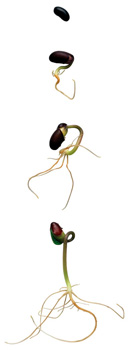Let’s Get Sprouting

This article is about releasing the wonderful nutrition of seeds by sprouting them; it tells you how to do it, how long it takes and what you gt out of it. Cancer nutrition is not the same as eating when you are well. Here Barbara Cox, the former Nutrichef who works with CANCERactive's Chris Woollams, gives her personal views for your cancer diet.
Packed with a superb balance of vitamins, minerals, protein, carbohydrates and fat, the seeds of a plant are our finest source of nutrition. But there’s something we have to do to them to unlock all of this potential - we have to trigger their growth (germination) into a young plant by soaking them in water for a few days. This process is called sprouting.
What Can We Sprout?
You might be surprised to hear that we can sprout just about any living vegetation, including beans, legumes, grains, nuts, seeds and even some grasses such as barley grass or wheat grass. However, the most common foods that people sprout are adzuki beans, mung beans, soya beans, chickpeas, oats, lentils, mustard, radish, quinoa, sesame seeds and sunflower seeds. When sprouted, these all make delicious snacks, especially when added to salads with a good dressing.
The Benefits Of Sprouting
In an age when most fruit and vegetables are grown in artificially fertilised soils and treated with all manner of chemicals including hormones, fungicides, insecticides and preservatives, seeds sprouted at home in a jar are a trusty, easily accessible source of organically grown nutrition.
Not only do many sprouted foods taste great, but they are also highly healthpromoting.
For starters, as a seed sprouts, the nutrients within increase their concentration in sheer quantum leaps: proteins by about 20%, nucleic acids by 30%, and many vitamins by a staggering 500%!
At the same time, enzymes dormant in seeds spring into life breaking down starch into simple sugars like fructose and sucrose and splitting proteins into amino acids. It’s also believed that this high enzyme activity stimulates the body’s own enzymes into greater activity. Interestingly, when dormant, chickpeas, lentils and mung beans are filled with enzyme inhibitors which not only make them difficult to digest - even when cooked - but can also interfere with our ability to absorb minerals in the food.
Sprouting And Cancer
Sprouted seeds are believed to have a number of anti-cancer properties:
1: They are high in nitrilosides, namely cyanide and benzaldehyde. These are powerful and potentially damaging chemicals that kill cancer cells but are repelled by normal body cells.
2: Chlorophyll, another major ingredient of sprouts, is highly alkalising and has anti-cancer properties.
3: Sprouted seeds are high in antioxidants like vitamin C, zinc and selenium, which neutralise ’free radicals’ - substances produced within our bodies that can damage tissue and accelerate the aging process.
How Do We Sprout Seeds?
The best way to sprout seeds is to buy a sprouter - a 3-tiered tray system. The process involved is as follows:
1: Choose your seeds - organic are best.
2: Place the seeds in a bowl and rinse them thoroughly in water.
3: Place them in your sprouter and cover them with cooled, boiled water.
4: Leave them overnight in a warm, dark place.
5: In the morning, rinse your seeds with fresh water and return them to the warm, dark location.
6: Do the same in the evening.
7: Repeat steps 5 and 6 until the seeds begin to sprout
8: When the seeds have begun to sprout, place them on a windowsill to get some warmth from the sun.
9: The sprouted seeds can now be removed from the sprouter.
10: Sprinkle the sprouts onto a salad or a stir-fry, or eat them as a snack in their own right.
Harvesting Times
The table below is an approximate guide to how long it takes to harvest different seeds.
SEED
Adzuki beans
Barley
Chickpea
Fenugreek
Flageolet beans
Green lentils
Green peas
Mung beans
Pumpkin seeds
Radish
Rye
Sunflower seeds
HARVESTING TIME (DAYS)
4-6
3-4
4-5
4-5
3-5
3-5
3-5
2-3
4-6
4-5
3-5
4-6
Problems With Sprouting
Alfalfa
Alfalfa - the most commonly sprouted seeds - are, ironically, best avoided as research shows these seeds may inhibit our immune function or heighten the symptoms of lupus or arthritis. The reason is that alfalfa contains an unusual amino acid called canavanine, which can be toxic to humans when eaten in large quantities.
Hard Seeds
We should eat slowly anyway, but especially when eating sprouted beans, just in case one of the beans hasn’t sprouted and is still rock hard. Hard seeds are nature’s protection system - the only problem is the system is to protect the seeds and not the unsuspecting consumer!
How do they protect the seeds? Well, if weather conditions or a fire happen to wipe out an entire crop of germinating seeds, a hard seed still under the ground will ensure that the species has a chance of surviving.
Sprouted Salad Recipe
It’s always nice to use a mixture of sprouts, as I’ve done in this recipe.
Ingredients
- 50g mangetout
- 50g sprouted chickpea
- and mung bean mix
- 25g mustard sprouts
- Chicory
- Bunch of watercress
Optional: 1 container of marinated tofu pieces (by Cauldron) Balsamic vinaigrette dressing or olive oil
Directions
Wash and dry the mangetout, chicory and watercress
Toss everything in a bowl and mix the balsamic vinaigrette dressing or olive oil with cracked pepper to taste.
Bon Appetit!

Sprouters can be bought from Barbara (tel 01202 748400) or from specialist kitchen shops. For further information on Nutrichef visit www.nutrichef.co.uk.